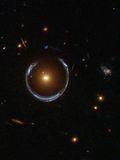
Astronomers have identified a potential new supermassive black hole with an estimated mass of 36 billion times that of the Sun. This discovery positions it as approximately 10,000 times heavier than the black hole at the center of the Milky Way, possibly making it one of the most massive objects ever detected. The findings were published in the Monthly Notices of the Royal Astronomical Society and stem from research conducted by the Institute of Cosmology and Gravitation at the University of Portsmouth in the UK, in collaboration with the Federal University of Rio Grande in Brazil.
The black hole is located within a gravitational lens known as the Cosmic Horseshoe, which was first discovered by the Hubble Space Telescope in 2007. A gravitational lens occurs when the gravity of a massive object, like a galaxy, bends light and time around it, distorting the light from objects behind it. In this case, the galaxy LRG 3-757 sits at the center of the Cosmic Horseshoe, while the surrounding blue horseshoe shape represents light emitted from a more distant galaxy.
LRG 3-757 is notable for its mass, which is estimated to be around 100 times that of the Milky Way. It is located approximately 5.6 billion light-years away from Earth. The unique structure of the Cosmic Horseshoe has allowed researchers to calculate the mass of the black hole that likely resides at the center of LRG 3-757. While direct observations of this black hole are not available, the measurements of light motion in the ring and the velocities of stars in the galaxy’s inner regions support the existence of an ultramassive black hole.
According to Thomas Collett, professor of astrophysics at the University of Portsmouth, “By combining these two measurements we can be completely confident that the black hole is real.” Collett further suggests that such a massive black hole could result from the merger of two supermassive black holes during galaxy collisions. This raises intriguing questions about the future of our own galaxy, the Milky Way, and its potential collision with the nearby Andromeda galaxy.
Astronomy enthusiasts are often aware that the most massive black hole currently recognized is TON 618, which has a mass estimated to be equivalent to 66 billion suns. This makes it nearly twice the mass of the Cosmic Horseshoe black hole. However, scientists exercise caution in labelling TON 618 as the definitive most massive object, as it is located more than 10 billion light-years away. The distant nature of TON 618 prevents detailed observation of its host galaxy.
The information we have about TON 618 primarily comes from brightness analysis and theoretical models, leading to significant uncertainty regarding its actual size. In contrast, researchers from the University of Portsmouth argue that the Cosmic Horseshoe black hole offers greater observational certainty, distinguishing it from other distant black holes that remain almost mythical in nature.
As such, the Portsmouth team believes their discovery could represent the most massive black hole confirmed to date, marking a significant milestone in our understanding of the universe’s most enigmatic objects. This finding not only advances scientific knowledge but also invites further investigation into the formation and evolution of supermassive black holes across the cosmos.







